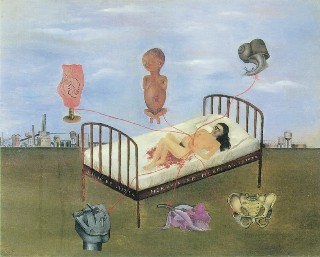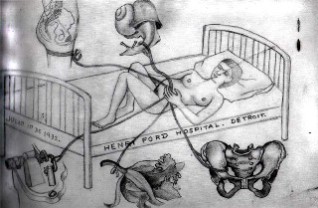Henry
Ford Hospital
(The Flying Bed)
1932
On July 4th, 1932, Frida suffered a miscarriage in the Henry Ford Hospital in Detroit. In this disturbing work, Kahlo paints herself lying on her back in a hospital bed after a miscarriage. The figure in the painting is unclothed, the sheets beneath her are bloody, and a large tear falls from her left eye. The bed and its sad inhabitant float in an abstract space circled by six images relating to the miscarriage. All of the images are tied to blood-red filaments that she holds against her stomach as if they were umbilical cords. The main image is a perfectly formed male fetus, little "Dieguito", she had longed to have. The orchid was a gift from Diego. "When I painted it I had the idea of a sexual thing mixed with the sentimental" Frida said. The snail she said, alludes to the slow paced miscarriage. The salmon pink plaster female torso she said was her "idea of explaining the insides of a woman". The cruel looking machine she invented "to explain the mechanical part of the whole business". Finally, in the lower right corner is her fractured pelvis that made it impossible for her to have children.
"Henry Ford Hospital" was Kahlo's first painting on tin. The painting contains all the basic elements of a "Frida style" ex-voto (retablo): small in size, painted on tin, depicts a tragic event and an inscription. The only not so obvious element is the "Saint" or "Savior". In this case it is the Henry Ford Hospital that saved her life.
In November of 1938, this painting was shown at Kahlo's first solo exhibition at the Julien Levy Gallery in New York City. It was shown with the title: "The Lost Desire".
This was Frida's first painting on metal. When the painting was finished it was photographed by Lola Alvarez Bravo. After the photograph, Frida decided to repaint her face and correct the spelling of the name of the hospital on the side of the bed.

(Click Here to View Larger Image)
(Pinche aquí para ver la imagen aumentada)
Oil on metal
12 ¼" x 15 ½"
Collection of Dolores Olmedo Patiño
Mexico City, Mexico
Óleo sobre metal
30,5 x 38
cm.
Colección
de Dolores Olmedo Patiño
Ciudad de México, México

Pencil Sketch Study
for Painting
Estudio borrador para la pintura
Henry
Ford Hospital
(La cama volando)
1932
El 4 de Julio de 1932, Frida sufrió un aborto involuntario en el hospital Henry Ford en Detroit. En éste turbador trabajo, Kahlo se pintaba a sí misma acostada en una cama de hospital después del aborto involuntario. La figura en el retrato está desnuda, las sábanas que se ven debajo de ella están ensangrentadas y una gran lagrima cae de su ojo izquierdo. La cama y su triste habitante flotan en un espacio abstracto, rodeado por seis imágenes en círculo relacionadas con la pérdida. Todas las imágenes están ligadas a filamentos de color rojo-sangre que ella sostiene contra su estómago, como si fueran cordones umbilicales. La imagen principal es un feto masculino perfectamente formado, el pequeño "Dieguito" que ella deseaba tanto tener. La orquídea fue un regalo de Diego. "Cuando yo lo pinté, tenia la idea de una cosa sexual mezclada con lo sentimental". El caracol, Frida explicó, alude al lento aborto involuntario. El torso femenino de yeso color salmón, Frida explicó que era su "idea de cómo explicar el interior de una mujer". La máquina de aspecto cruel que ella inventó "para explicar la parte mecánica de todo el asunto". Finalmente, en la esquina inferior derecha es su pelvis fracturada que hizo imposible para ella tener hijos.
“Henry Ford Hospital " fue el primera cuadro de Kahlo pintada sobre estaño. Esta pintura contiene todos los elementos básicos de un ex-voto (retablo) "estilo Frida": tamaño pequeño, pintado sobre estaño, muestra un evento trágico y una inscripción. El único elemento que no es tan obvio es el "Santo" o "Salvador". En este caso, fue el hospital Henry Ford, quién le salvó su vida.
En Noviembre de 1938, este cuadro se mostró en la primera exposición individual de Kahlo en la Galería Julien Levy de Nueva York. Se mostró con el título: "The Lost Desire" (El deseo perdido).
Esta fue la primera pintura de Frida en metal. Cuando la pintura estuvo acabada, Lola Álvarez Bravo la fotografió. Después de ver la fotografía, Frida decidió pintar la cara de nuevamente y corregir el nombre del hospital inscrito en el costado de la cama.